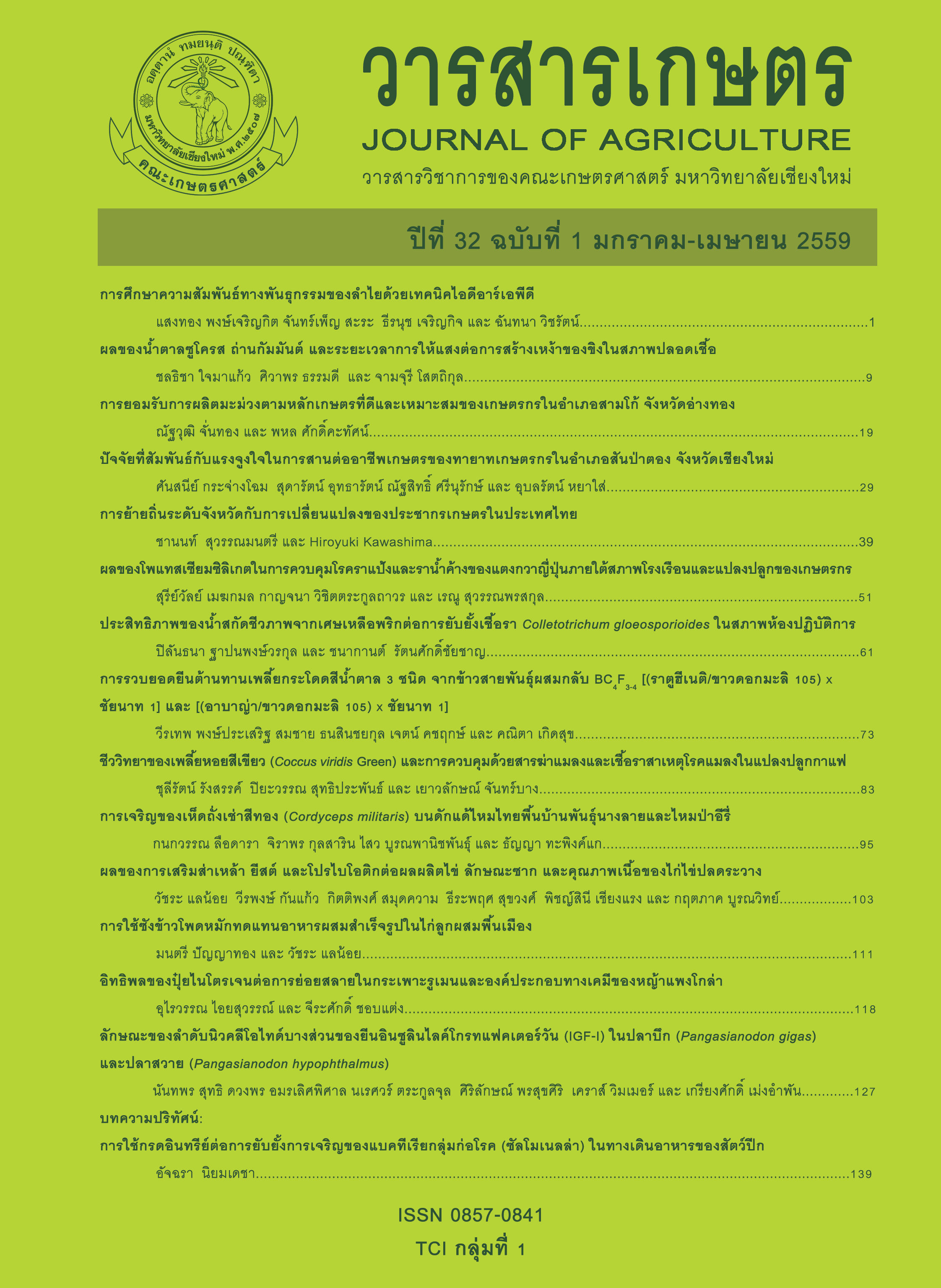ผลของการเสริมส่าเหล้า ยีสต์ และโปรไบโอติกต่อผลผลิตไข่ ลักษณะซาก และคุณภาพเนื้อของไก่ไข่ปลดระวาง
Main Article Content
บทคัดย่อ
ศึกษาผลของการเสริมส่าเหล้า ยีสต์ และโปรไบโอติก ต่อผลผลิตไข่ ลักษณะซาก และคุณภาพเนื้อของแม่ไก่ไข่ปลดระวาง ใช้ไก่ไข่พันธุ์ ISA Brown อายุ 85 สัปดาห์ จำนวน 600 ตัว วางแผนการทดลองแบบสุ่มตลอด แบ่งเป็น 4 กลุ่มการทดลอง จำนวน 6 ซ้ำ ๆ ละ 25 ตัว โดยที่ก่อนปลดระวาง 21 วัน เสริมอาหารตามสูตรดังต่อไปนี้ อาหารพื้นฐานเป็นกลุ่มควบคุม (T1) อาหารพื้นฐานเสริมส่าเหล้าในระดับ 1 เปอร์เซ็นต์ (T2) อาหารพื้นฐานเสริมยีสต์ (Saccharomyces cerevisiae) แบบผงแห้งในระดับ 0.5 เปอร์เซ็นต์ (T3) และกลุ่มอาหารพื้นฐานเสริมโปรไบโอติกทางการค้า (Bacillus cereus var. toyoi) 0.1 เปอร์เซ็นต์ (T4) ผลการทดลองพบว่าการเสริมส่าเหล้า ยีสต์ และโปรไบโอติกในช่วง 21 วันก่อนปลดระวาง ไม่มีผลต่อเปอร์เซ็นต์การให้ไข่ และส่วนประกอบของซาก ไข่แดงของไก่กลุ่ม T3 และ T4 มีค่าสูงกว่ากลุ่มควบคุมและกลุ่มที่เสริมด้วยส่าเหล้า อย่างมีนัยสำคัญ (P<0.05) ส่วนน้ำหนักพวงไข่มีแนวโน้มสูงขึ้นในกลุ่มที่ได้รับส่าเหล้า (P=0.052) อย่างไรก็ตามการเสริมส่าเหล้าทำให้ค่าความเป็นสีแดง a* ของเนื้อมีแนวโน้มลดลง (P=0.053) ค่าความเป็นกรดเป็นด่าง และแรงตัดผ่านเนื้อ ไม่มีความแตกต่างกันทางสถิติ
Article Details
เอกสารอ้างอิง
นวรัตน์ พรสวัสดิ์ชัย วิโรจน์ กิติคุณ รุ่งจรัส หุตะเจริญ วันชัย ผาติหัตถกร ธวัธชัย ศุภดิษฐ์ สัญชัย จตุรสิทธา จำลอง ศรีสุวรรณ์. 2545. ผลของการใช้กากส่าเหล้าแห้งผสมในอาหารนกกระทาไข่: ช่วงอายุ 32-36 สัปดาห์. หน้า 337-343. ใน: ทัศนีย์ อภิชาติสรางกูร สัญชัย จตุรสิทธา อังคณา ผ่องแผ้ว(บก.) รายงานการประชุมวิชาการสาขาสัตวบาล/สัตวศาสตร์/สัตวแพทย์ศาสตร์ ครั้งที่ 3. บริษัท ทรีโอ แอดเวอร์ไทซิ่ง แอนด์ มีเดีย จำกัด, เชียงใหม่.
วรรณพร ทะพิงค์แก. 2557. ทางเลือกในการทดแทนการใช้ยาปฏิชีวนะเป็นสารเร่งการเจริญเติบโตสำหรับปศุสัตว์. วารสารเกษตร 30(2): 201-212.
สัญชัย จตุรสิทธา. 2543. เทคโนโลยีเนื้อสัตว์. โรงพิมพ์ธนบรรณการพิมพ์. เชียงใหม่. 244 หน้า.
สุจินต์ พนาปวุฒิกุล. 2541. การใช้กากส่าเพื่อการเกษตร. การประชุมวิชาการ มหาวิทยาลัยรังสิต ครั้งที่ 3 เรื่อง เทคโนโลยี เศรษฐกิจการศึกษา มหาวิทยาลัยรังสิต ปทุมธานี; 21-22 มกราคม 2541.
Aghaii, A., M. Chaji, T. Mohammadabadi and M. Sari. 2010. The effect of probiotic supplementation on production performance, egg quality and serum and egg chemical composition of laying hens. Journal of Animal and Veterinary Advances 9(21): 2774-2777.
AMSA. 1991. Guideline for meat color evaluation. American Meat Science Association. Illinois. USA.
Bradley, G. L., T. F. Savage and K. I. Timm. 1994. The effects of supplementing diets with Saccharomyces cerevisiae var.boulardii on male poult performance and ileal morphology. Poultry Science 73(11): 1766-1770.
Chung, S. H., J. Lee and C. Kong. 2015. Effects of multi strain probiotics on egg production and quality in laying hens fed diets containing food waste product. International Journal of Poultry Science 14(1): 19-22.
Corzo, A., M. W. Schilling, R. E. Loar II, V. Jackson, S. Kin and V. Radhakrishnan. 2009. The effects of feeding distillers dried grains with solubles on broiler meat quality. Poultry Science 88:432-439.
Gordon, R., M. M. Bryant and D. A. Roland Sr. 2009. Performance and profitability of second-cycle laying hens as influenced by body weight and body weight reduction during molt. Journal of Applied Poultry Research 18: 223-231.
Heuze, V., D. Sauvant, G. Tran and F. Lebas. 2014. Brewers grains: A programme by INRA, CIRAD, AFZ and FAO. (Online). Available: http://www.feedipedia.org/node/74 (March 15, 2015).
Jaturasitha, S., T. Srikanchai, M. Kreuzer and M. Wicke. 2008. Differences in carcass and meat characteristics between chicken indigenous to Northern Thailand (Black-boned and Thai Native) and imported extensive breeds (Bresse and Rhode Island Red). Poultry Science 87: 160-169.
Kondaiah, N. and B. Panda. 1992. Processing and utilization of spent hens. Would Poultry Science 48: 255-265.
Lee, S. O., J. S. Min, I. S. Kim and M. Lee. 2003. Physical evaluation of popped cereal snacks with spent hen meat. Meat Science 64: 383-390.
Mahdavi, A. H., H. R. Rahmani and J. Pourreza. 2005. Effect of probiotic supplements on egg quality and laying hen’s performance. International Journal of Poultry Science 4(7): 488-492.
Mikulski, D., J. Jankowski, J. Naczmanski, M. Mikulska and V. Demey. 2012. Effects of dietary probiotic (Pediococcus acidilactici) supplementation on performance, nutrient digestibility, egg traits, egg yolk cholesterol, and fatty acid profile in laying hens. Poultry Science 91: 2691-2700.
Parvu, M. and M. T. Paraschivescu. 2014. Feeding Rhodotorula rubra Yeast in egg yolk pigmentation (II). Romanian Biotechnological Letters 19: 9959-9963.
R Core Team. 2014. R: A language and environment for statistical computing. R Foundation for Statistical Computing, Vienna, Austria. url http://www.R-project.org.
Savell, J. W., S. L. Mueller and B. E. Baird. 2005. The chilling of carcasses. Meat Science 61:103–113.
Souza, K. M. R. de, R. B. Araujo, A. L. dos Santos, C. E. C. Rodrigues, D. E. de Faria and M. A. Trindade. 2011. Adding value to the meat of spent laying hens manufacturing sausages with a healthy appeal. Brazilian Journal of Poultry Science 13(1): 57-63.
Vaithiyanathan, S., B. M. Naveena, M. Muthukumar and P. S. Girish. 2008. Biochemical and physicochemical change in spent hen breast meat during postmortem aging. Poultry Science 87: 180-186.
Van M. and W. S. De smet. 1999. Effect of time of deboning and sample size on drip loss of pork. Meat Science 52: 151-156.


